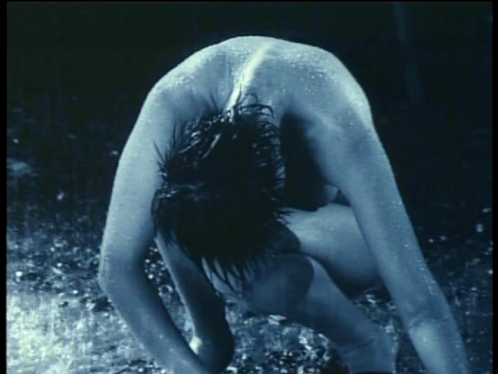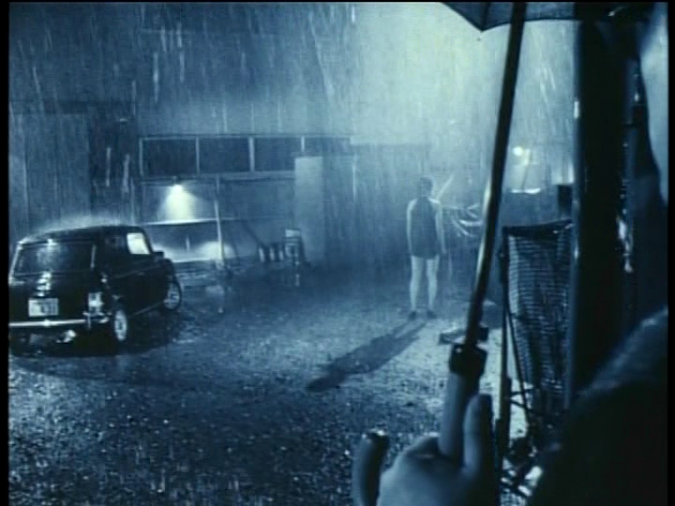 Some movies you watch and some movies you experience; despite being visually one of the most tightly and carefully crafted movies of all time, Shinya Tsukamoto’s A Snake of June is a movie you experience.
Some movies you watch and some movies you experience; despite being visually one of the most tightly and carefully crafted movies of all time, Shinya Tsukamoto’s A Snake of June is a movie you experience.
In a remarkable characterization by Asuka Kurosawa, Rinko seems to be a well-adjusted woman in her thirties. She works as a phone counselor in a mental health clinic and seems happy at home, where her balding older salaryman husband insists on doing the cleaning, though this appears to be an obsession rather than any attempt to help out around the house. There is one problem in the marriage, however; for unstated reasons, the husband always sleeps in the living room, to Rinko’s great disappointment. Rinko has resorted to masturbation at times, and one day she receives an envelope of photos of her doing so. Before long, this turns into a stalker situation, with photos arriving that could only have been taken from inside her house.
The stalker calls on the phone and offers her the negatives if she puts on the very short skirt he photographed her wearing in private and then walks around in public without her underwear. He eventually forces her to buy a vibrator and walk around with that while he controls it with the remote. As anyone might expect, this is horrifying to her and to us as well, the tension rising with each sequence. But surprisingly, he does return the negatives and turns his attention to the husband, whom he humiliates and beats. The now jealous husband follows her one night when she voluntarily goes out in her short skirt and observes as she herself turns on the vibrator, eventually stripping in the rain as she orgasms while her stalker takes flash photos from his car. 
In outline, it sounds like an exploitation film, particularly as it concludes with a pair’s orgasm, but it is anything but. We do not see Kurosawa nude until the rain photo scene, very late in the film. If it is possible to narrow the complexity down to a single theme, it would be cancer rather than sex. Not only do we find that the stalker has cancer so bad he has contemplated suicide, but Rinko apparently has breast cancer. Even more significant is the cancer that Tsukamoto identifies within the society as a whole, a society in which personal roles so constrict each person that they cease to have a personality or a will of their own. Rinko on the phone had talked the stalker out of suicide, not knowing about his cancer, by telling him there is a different person inside that he can release that will make him want to live, and he wants to return the favor before he dies by freeing up the part of her that she has always repressed.
Rinko and her husband live in a sterile apartment, blank stone walls and modernist recessed lighting, and their relationship is sterile as well, before we even consider his obsessive cleaning.
Like his cleaning, the movie itself is obsessive: it is June, the month when the rains usually begin in Tokyo, and the rain is ever-present in some way in almost every shot, on the windows, on the streets, or mirrored in sweat. Tsukamoto has said the rain allows the weeds to break through the sterility of modern Tokyo and to release more fundamental life forces, so in a weird way the movie uses water as did Imamura in Warm Water Under a Red Bridge, a connection between two utterly different film-makers that I never thought I would see myself making. When not looking at the rain, the screen is filled with circles – the lens of the camera, the drains of the tub or sink, the constant umbrellas, a strange laundry-like container in which people in nightmares drown as it fills with water, and the drains on the street down which the rains eventually pour.
Filmed in black and white tinted with blue in the old 4×3 format, it looks like no other movie I can recall from any nation. Though some of the husband’s scenes have a David Lynch-like dream quality, the movie is all Tsukamoto, the camera restless yet always clear, the shots brief yet cut together so smoothly that they appear seamless. He produced, wrote, directed, designed, photographed, and edited the movie, but it never looks or feels like a vanity project. The cast, as has often happened in the Tsukamoto movies I have seen, are people who were not known as actors yet produce brilliant, intense, and genuine performances:
Kurosawa was a model before this, her husband is played by the novelist Yoji Kotari, and while Tsukamoto plays the stalker, he keeps himself off the screen for most of the movie. It is the letters, the phone calls, and his mysterious motives rather than his actual presence that provide the power of his character. Never does he let us lose sight of Rinko and her sense of confusion, fear, shock, humiliation, and yet eventually of release and rediscovery of herself.
I don’t want to write a dissertation on the movie, though its obsessive use of visual motifs would certainly make that possible. Its real power comes from its ability to draw the viewer into Rinko’s life and to make us feel as if we are in a horror movie ourselves, just as she does. It is an unique and unforgettable film.
* As began to be common among Japanese independent directors around 2000, Snake of June was first seen in several international festivals in 2002 before it finally went into general release in Japan in 2003.




Pingback: Vital (2004) | Japanonfilm
Pingback: Nightmare Detective / Akumu tantei (2006) | Japanonfilm
Pingback: Marebito (2004) | Japanonfilm